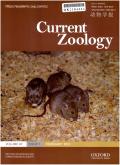Acoustic complexity of pup isolation calls in Mongolian hamsters: Three-frequency phenomena and chaos
IF 2
2区 生物学
Q2 ZOOLOGY
引用次数: 0
Abstract
Studying pup isolation calls of wild rodents provides background for developing new early-life animal models for biomedical research and drug testing. This study discovered a highly complex acoustic phenotype of pup isolation calls in 4–5-days-old Mongolian hamsters Allocricetulus curtatus. We analysed the acoustic structure of 5010 isolation calls emitted in the broad range of frequencies (sonic, below 20 kHz, and ultrasonic, from 20 to 128 kHz) by 23 pups during 2-min isolation test trials, one trial per pup. In addition, we measured five body size parameters and the body weight of each pup. The calls could contain up to three independent fundamental frequencies in their spectra, the low (f0), the medium (g0) and the high (h0), or purely consisted of chaos in which the fundamental frequency could not be tracked. By presence/absence of the three fundamental frequencies or their combinations and chaos, we classified calls into six distinctive categories (Low-Frequency-f0, Low-Frequency-chaos, High-Frequency-g0, High-Frequency-h0, High-Frequency-g0+h0, High-Frequency-chaos) and estimated the relative abundance of calls in each category. Between categories, we compared acoustic parameters and estimated their relationship with pup body size index. We discuss the results of this study with data on the acoustics of pup isolation calls reported for other species of rodents. We conclude that such high complexity of Mongolian hamster pup isolation calls is unusual for rodents. Decreased acoustic complexity serves as good indicator of autism spectrum disorders in knockout mouse models, which makes knockout hamster models prospective new wild animal model of neurodevelopmental disorders.蒙古仓鼠幼鼠隔离叫声的声学复杂性:三频现象和混沌
研究野生啮齿动物幼犬的隔离叫声为开发新的早期动物模型提供了背景,可用于生物医学研究和药物测试。本研究在4 - 5日龄蒙古仓鼠异角仓鼠中发现了一种高度复杂的幼鼠隔离叫声声学表型。我们分析了23只幼犬在2分钟的隔离试验中发出的5010声隔离叫声的声学结构,这些叫声在宽频率范围内(声波,低于20 kHz,超声波,从20到128 kHz),每只幼犬进行一次试验。此外,我们还测量了每只幼犬的5个体型参数和体重。呼叫可以在其频谱中包含多达三个独立的基频,低(f0),中(g0)和高(h0),或者纯粹由混沌组成,其中基频无法被跟踪。根据三个基本频率或它们的组合和混沌的存在/缺失,我们将呼叫分为六个不同的类别(低频- 0,低频-混沌,高频- 0,高频- 0,高频- 0,高频- 0+h0,高频-混沌),并估计了每个类别中呼叫的相对丰度。在不同类别之间,我们比较了声学参数并估计了它们与幼犬体型指数的关系。我们讨论了这项研究的结果与声学的幼犬隔离呼叫报告其他种类的啮齿动物的数据。我们的结论是,蒙古仓鼠幼仔隔离呼叫的高度复杂性在啮齿动物中是不寻常的。在敲除小鼠模型中,声音复杂性降低是自闭症谱系障碍的良好指标,这使得敲除仓鼠模型有望成为神经发育障碍的新的野生动物模型。
本文章由计算机程序翻译,如有差异,请以英文原文为准。
求助全文
约1分钟内获得全文
求助全文
来源期刊

Current Zoology
Agricultural and Biological Sciences-Animal Science and Zoology
CiteScore
3.20
自引率
9.10%
发文量
111
审稿时长
6 weeks
期刊介绍:
About the Journal
Current Zoology (formerly Acta Zoologica Sinica, founded in 1935) is an open access, bimonthly, peer-reviewed international journal of zoology. It publishes review articles and research papers in the fields of ecology, evolution and behaviour.
Current Zoology is sponsored by Institute of Zoology, Chinese Academy of Sciences, along with the China Zoological Society.
 求助内容:
求助内容: 应助结果提醒方式:
应助结果提醒方式:


